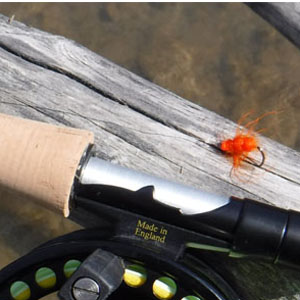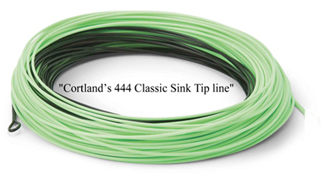
A BEGINNERS GUIDE: FLY FISHING FOR STEELHEAD

ARTICLE BY INDREK KONGATS, NOVEMBER 4, 2016
If you are reading this column to learn how to fly fish for one of the most challenging of the Salmonidae species, then you have come to the right place. If youíve never fly fished before, no problemówhat youíll read will help you with that as well.
Most people fly fish because itís the most elegant way to hook and land a fish, and if the fish arenít biting, itís just plain fun to cast a line. 
A quick introduction to fly fishing and what sets it apart from other types of fishing: to start with fly casting isnít really about casting a fly; itís about casting the line that the fly is attached to. The fly is for catching fish, the rod is for casting the line and fighting the fish, the line is to get the fly to where the fish areÖhave I lost you yet?
Letís step back a bit. Most people have fished before, especially if they are interested in becoming fly fishers, men, women or kids. If you have fished with a spinning reel or a level wind bait casting reel, then what you were doing is casting a weighted object, a hook and sinker for live or dead bait or an artificial lure, whether itís made out of metal, plastic or wood. When you wind up for a cast, itís the weighted object that pulls the line off the reel; the line is only meant to retrieve the weighted object, hopefully with more weight than first cast out.
Imagine picking up a feather and tossing it across a football field or the length of a basketball court. Impossible you say? Well, you are rightóit is impossible, but not if you are an expert fly caster that can cast that feather on the end of a fly line well over 100 feet. The feather has no weight, but the fly line does and that is what you are trying to cast.
There are different types of fly lines, but the one that most people use is the weight forward kind, unless, of course, you are trying to do something very special. 
Weight forward fly lines are just tható start off with a uniform line that slowly starts to get thicker toward the end. Thatís the weighted part. To the fly line, you attach a leader that is tapered in the other direction, thinnest toward the end. To the leader, you attach a tippet; the tippet is not tapered, but is replaceable if it breaks off from the leader. To the tippet, you tie your fly.
Fly lines are expensive; you donít want to lose them, so you attach some Dacron type line to your reel and the other end to your fly line. Thatís the whole outfit: rod, reel, fly line, backing, leader and tippet.
Fly fishing is a bit like golf; youíll have a different rod and fly line for different species of fish and different river conditions. In golf, one of the most popular and easy to hit clubs is the seven iron; in steelhead fishing, it is a 7 weight rod. The fly line is matched, so youíll be using a 7 weight fly line or a WF7F, for steelhead. Weíll actually use a WF7FS, which just means a floating weight forward line with a sink tip. The sink tip is important in steelhead fishing because you need to get your fly down to the fish.
I havenít talked about reels because any fly reel will do, as long it is large enough to hold all of your fly line components. Letís talk about the fly itself. A fly is a hook dressed to kill, meaning that steelhead like their women and men dressed a certain way or they wonít take you up on a date. As in people, a steelhead likes certain colors over others. The most significant color is orange, followed by black. If you had only orange and black flies in your fly box, youíll catch steelhead most of the time. 
Many anglers have their own favorite color, so donít get too caught up with what I just said; it is merely a very good starting point. In fact, these are the only two colors that I use unless I need something sparkly in very dirty water when something like silver tinsel is added to the fly to do the trick. The fly is tied to a hook and different types and sizes of hooks are used for different techniques and conditions. Larger hooks are for aggressive fish in warmer and higher water, whereas smaller hooks are for lazy fish in colder low water conditions. Steelhead are more aggressive when the water temperature is 50 degrees or higher, and more lethargic under 50 degrees.
A true fly fisher will not put weight on his leader. What is permissible in fly fishing is to use a weighted fly, meaning that when the fly is tied, lead wire, the use of a thicker hook, bead heads and lead eyes are used in tying the fly. A weighted fly will help get the fly closer to the steelhead under certain conditions and techniques. The main technique for using a small weighted fly is called dead drifting, or nymphing, where the fly drifts across the bottom with little or no resistance. When you use a non-weighted or larger fly, you swing it across the current below you.
So here goes, you walk down to the riverís edge with your fly rod in hand. You have to ask yourself, ďAm I fishing deep and dead drifting or am I swinging my fly across current?Ē
The swing is by far the easiest to master, so letís stick to that. Start by casting a short line down and across the river and let the fly swing and dangle below you. Donít even enter the water at this point. Next pull another two feet of line off your reel and cast again. Do this until you have reached your maximum casting distance, this maybe only 20 feet for the beginner or 60 feet if the stream is wide enough.
Next, step two feet into the water and cast again. Work your way down the river until you have fished the entire section of river that looked promising.
Continue working sections of water until you finally get a strike. Remember the spot and the technique, fly and conditions for the next time you go!
back to main menu

|